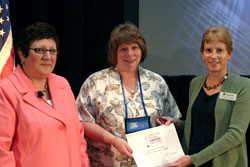Best of Show
<< back to Simulation National Leadership Conference 2010 Home page

Wed. 9/15/2010
Participants attending the Simulation National Leadership Conference selected the poster "Using Simulation to Assess New Employees' Skills and Critical Thinking" as best-of-show. LeAnn Schlamb, RN, MSN, from VISN 10 presented the poster at the session Wednesday afternoon.
According to the poster presentation, new employee assessment simulations occur after the new employees complete classroom orientation because it is dangerous to assume a new nurse or nurse aide can perform on the job safely and competently. Part of the assessment introduces new or unfamiliar equipment in order to familiarize new employees prior to caring for Veteran patients.
Novice nurses or registered nurses new to a facility and/or to the type of patients benefit from the practical learning that simulation provides. Using simulation, new and current employees can complete position-specific competencies in a safe environment. At the beginning of the simulation experience, the nursing employees reflect on their abilities to perform identified skills and competencies. In addition to providing nursing employees the opportunity to develop and display competencies with new equipment, the simulation assessment uses iSTAN, and Nursing Kelly:
- involves critical thinking using a brief scenario with debriefing to identify abnormal vital signs, and/or arrhythmias,
- identifies rapid response situations, and
- Diagnostic skills, proficiencies, and critical thinking
- uses Situation Background Assessment Response (SBAR) communication and hand-off communication.
Upon completing the simulation experience, the new employees and the educators have the opportunity to provide feedback regarding completion of skills and any areas of weaknesses. This enables the instructor or manager to provide individualized orientation experiences for each new employee. Positive feedback from new employees and nurse managers during the past 12 months indicates the success of the simulation program.



















